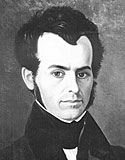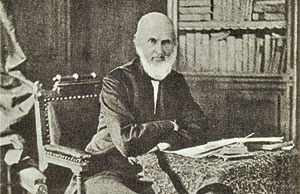John Greenleaf Whittier (1807-1892)
 As a young man Whittier joined the abolitionist cause and helped form the Republican Party. |
John Greenleaf Whittier, born December 17, 1807 in the southwest Parlor of the Whittier Birthplace, was the first son and second child of John and Abigail (Hussey) Whittier. He grew up on the farm in a household with his parents, a brother and two sisters, aunt and uncle, and a constant flow of visitors and hired hands for the farm.
Whittier’s first poem to be seen in print appeared in 1826 in the Newburyport Free Press, where the abolitionist William Lloyd Garrison was editor. Under Garrison’s encouragement Whittier actively joined the abolitionist cause and edited newspapers in Boston and Hartford. He was associated with the Atlantic Monthly Magazine from 1857 until his death.
 Whittier is best known for his poem Snow-Bound, |
In 1831, he brought out a book of prose works, “Legends of New England,” and the next year returned to his native town to run the farm after his father’s death, and later moved to Amesbury. Until the Civil War, he became increasingly involved in the abolitionist cause, serving in numerous capacities on the local, state and national levels. He was also involved in the formation of the Republican Party.
With the publication of Snow-Bound in 1866, Whittier finally enjoyed a relatively comfortable life from the profits of his published works. It is Snow-Bound for which he will always be best remembered as a poet. Nearly every volume of his verses published thereafter was truly a best seller. Whittier died on September 7, 1892 at a friend’s home in Hampton Falls, NH, and was buried with the rest of his family in Amesbury.
1807
Born December 17 in Haverhill, Massachusetts, on the farm remembered in “Snow-Bound,” to John and Abigail Hussey Whittier, the second of four children. The Whittiers came to New England in 1638 and the first Whittier had, in his old age, personally built the house in which Whittier was born.
1814-1815
Begins to attend the short winter terms of the district school.
1821
One of his teachers introduces him to the poetry of Burns and he begins to write verses himself.
1826
Sister Mary sends “The Exile’s Departure,” an imitation of Scott, to the Newburyport Free Press, whose editor, the young William Lloyd Garrison, publishes it and seeks out the author to encourage him to get an education and develop his literary talents.
1826-1827
Thus encouraged, Whittier sends out many poems to local newspapers, which accept more than eighty of them. The works of Scott and Byron seem to have furnished the models from these fluent, “correct,” and often-florid verses in which Whittier found neither his own voice nor his own subjects. When preparing the notes for his definitive edition late in life, Whittier described one of them as suggesting (1827-1828) “the idea of a big Indian in his war-paint strutting about in Sir Walter Scott’s plaid.”
1829
Supports himself by shoemaking and school teaching for two terms at Haverhill Academy, completing his formal education.
1830
Edits the Boston weekly newspaper, The American Manufacturer, a position obtained for him by Garrison. Supports Clay and high tariffs and attacks Jackson and populist democracy.
1830-1832
Edits the Essex Gazette (Haverhill), a less prestigious position which enables him to live at home. His father dies.
Edits the important New England Review in Hartford for some eighteen months. Nervous and physical exhaustion force his resignation and second return to the farm. Publishes Legends of New England, his first book, a mixture of prose and verse aimed at showing that “New-England is rich in traditionary lore…”; he later deprecates the work and refuses to permit it reprinting.
1833
Hoping for a career in politics, he is elected to the state convention of the National Republican party and unsuccessfully seeks office as a Whig.
Urged by Garrison, joins the Anti-Slavery party and is a delegate to the first meeting of the American Anti-Slavery Convention. Begins to write Abolitionist verses and publishes Justice and Expediency, a powerful anti-slavery tract.
1835
Elected to the Massachusetts legislature. Continues to live at home and oversee the management of the farm. Edits the Haverhill Gazette.
1836
Sells the farm and moves with his mother and sisters to nearby Amesbury, where he continues to live until his last years.
1837
Works actively for the Abolitionist cause in New York and Philadelphia. A collection of his Abolitionist verse, Poems Written during the Progress of the Abolition Question in the United States, appears in print.
1838
Publishes the first authorized collection of his poetry, Poems. Edits the Pennsylvania Freeman.
1839
Breaks with Garrison over the issue of Abolitionist tactics and helps to found the Liberty party, which he hopes will find for the antislavery cause a wider political base than Garrison’s radical Abolitionism.
1840
Resigns the editorship of the Pennsylvania Freeman in ill health and returns home for good.
Begins his gradual withdrawal from political activism.
The publication of Lays of My Home suggests the renewal of his early interest in regional and historic subjects for his verse.
Edits the Middlesex Standard in Lowell.
Publishes Voices of Freedom.
Becomes a corresponding editor of the National Era, which serves as the chief outlet for his poetry and prose for the next decade. Publishes Super-Naturalism in New-England, which Hawthorne, reviewing the volume, finds somewhat deficient in imagination.
Publishes Margaret Smith’s Journal.
Publishes Songs of Labor, Poetical Works, and Old Portraits and Modern Sketches. During the 1850’s writes many of his best poems, including “Telling the Bees,” “Skipper Ireson’s Ride,” and “The Double-Headed Snake of Newbury,” signaling his beginnings to find his poetic role as “the poet of the commonplace” and of New England’s past.
Persuades Charles Sumner to run for the Senate. After Sumner’s election, the shift of Whittier’s poetic energies from the political to the personal and legendary becomes still more pronounced.1857
With the founding of the Atlantic Monthly, he is assured for the first time of a wide reading public in the company of the period’s most respected authors. Mother dies.
1860
Publishes Home Ballads. Sister Mary dies.
1864
Sister Elizabeth dies. A niece, also named Elizabeth, moves into the Amesbury home to look after him. With the Emancipation Proclamation and the Union victory in the Civil War, he feels that the cause of freedom has been won and he may rest from his reforming labors.
1866
Snow-Bound, his masterpiece, is an immense popular success and gives him financial security for the first time.
1867
The Tent on the Beach, and Other Poems makes explicit his decision to “lay aside grave themes, and idly turn / The leaves of memory’s sketch-book.” Writes an increasing number of religious and devotional poems.
1870
Ballads of New England
1872
The Pennsylvania Pilgrim, and Other Poems, containing “The Brewing of Soma” the final stanzas of which, beginning “Dear Lord and Father of Mankind,” have become Whittier’s best -known hymn.
1886
Harvard grants him an honorary LL.D., a somewhat belated acknowledgment that is age had come to think of the “uneducated farm boy” and one-time “radical” reformer as belonging in the company of Harvard-educated Emerson, Lowell, and Holmes and Bowdoin-educated, Harvard-associated Longfellow.
1888-1889
Houghton Mifflin Co., the country’s most distinguished publishing house of the period, issues a definitive edition of his poetry and prose in seven volumes.
1890
Privately prints his last book, At Sundown.
1892
Dies September 7 at Hampton Falls, New Hampshire and is buried in the family plot in Amesbury, where in his boyhood his family had regularly attended Friend’s Meeting.